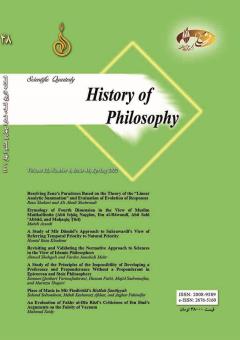-
-
List of Articles
-
Open Access Article
1 - Editor's Note
Hossein Kalbasi Ashtari -
Open Access Article
2 - Resolving Zeno’s Paradoxes Based on the Theory of the “Linear Analytic Summation” and Evaluation of Evolution of Responsesa
Reza Shakeri Ali Abedi Shahroodi -
Open Access Article
3 - Etymology of Fourth Dimension in the View of Muslim Mutikallimūn (Abū Isḥāq Naẓẓām, Ibn al-Rāwandī, Abū Sahl ‘Abbād, and Muḥaqiq Ṭūsī)
Mahdi Assadi -
Open Access Article
4 - A Study of Mīr Dāmād’s Approach to Suhrawardī’s View of Referring Temporal Priority to Natural Priority
Hamidreza Khademi -
Open Access Article
5 - Revisiting and Validating the Normative Approach to Sciences in the View of Islamic Philosophers
Ahmad Shahgoli Fardin Jamshidi Mehr -
Open Access Article
6 - A Study of the Principles of the Impossibility of Developing a Preference and Preponderance Without a Preponderant in Epicurean and Stoic Philosophers
Samane Qanbari Varnusfaderani Hassan Fathi Majid Sadremajles Morteza Shajari -
Open Access Article
7 - Place of Music in Mīr Findiriskī’s Risālah Ṣanāiyyah
Sahand Soltandoost Mehdi Keshavarz Afshar Asghar Fahimifar -
Open Access Article
8 - An Evaluation of Fakhr al-Dīn Rāzī’s Criticisms of Ibn Sīnā’s Arguments on the Falsity of Vacuum
Mahmud Seidy
-
The rights to this website are owned by the Raimag Press Management System.
Copyright © 2017-2025







